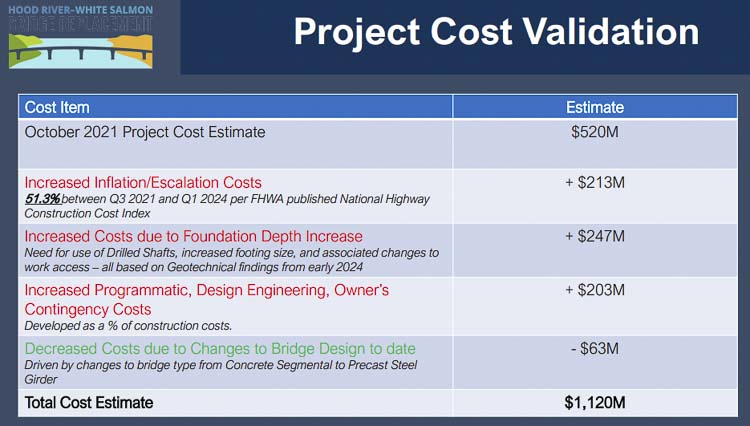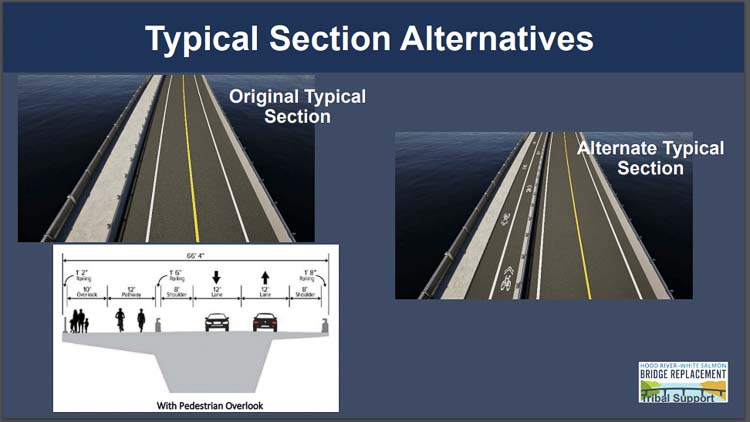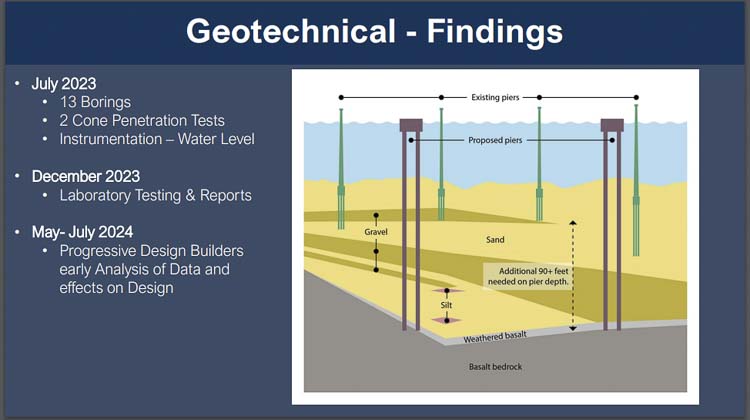Could the price of the Interstate Bridge replacement also double?
John Ley
For Clark County Today
At the Tuesday, Nov. 5 Regional Transportation Council (RTC) Board meeting, an update on the Hood River-White Salmon bridge replacement project was presented. The project has been under discussion for a quarter century and will feature one lane in each direction plus bike/pedestrian lanes. It will offer 90 feet of clearance for marine vessels.
The cost of the bridge has exploded 215 percent. It was originally planned at $520 million in 2021. The update revealed the new projected cost is $1.12 billion.
Michael Shannon, project director, indicated inflation was responsible for 51 percent of the cost increase, or $213 million. Soil samples in test drilling sites indicated the bridge piers will need to be approximately 90 feet deeper than planned. That will add $247 million to the cost.

Shannon reported “increased programmatic, design engineering, owner’s contingency costs developed as a percent of construction costs add another $203 million.” Those “contingency costs” are 30 percent, according to Shannon.
This huge cost increase should serve as a cautionary tale for the Interstate Bridge Replacement Program (IBR). The current cost range of a $5-$7.5 billion range is expected to rise, according to Program Administrator Greg Johnson. But details won’t be revealed until next summer (2025). Economist Joe Cortright has been predicting at least a $9 billion price tag.
The Draft Supplemental Environmental Impact Statement (DSEIS) uses a figure of $6 billion. If the IBR experiences a similar cost explosion, the I-5 Bridge project could surge to a range of $10.5 billion to $16.125 billion.
Some might doubt the IBR costs could explode this much, but during the same RTC Board meeting, it was revealed by Ron Arp of the Clark County Transportation Alliance that it was likely additional dollars from the states would be needed for the I-5 project. RTC Director Matt Ransom mentioned cost escalation for several Clark County projects, including the IBR and the 179th interchange near the fairgrounds.
Included in the meeting package was a list of projects including the Camas Slough Bridge, now priced at $125 million. This was originally a $25 million project funded by the state legislature in the 2015, $16 billion Connecting Washington transportation package. Two years later, cities including Camas and Washougal requested that funding be shifted to widening Highway 14 between I-205 and 164th Avenue.
A recent fatal accident at the Camas Slough Bridge has renewed calls for its replacement. But the 500 percent cost increase should add to citizens’ concerns about the affordability of the Interstate Bridge project and the ability of government agencies to deliver transportation projects.
In November 2021, President Biden signed the Infrastructure Investment and Jobs Act (IIJA). It was heralded to fix the nation’s infrastructure, with transportation receiving the largest share. The $1.2 trillion package was unprecedented in both size and scope. One report indicated 452 unique funding pots and over $850 billion in total funding available.
“The price hikes already are diminishing the value of a $1 trillion infrastructure plan President Joe Biden signed into law just seven months ago,” according to AP. “That law had included, among other things, a roughly 25 percent increase in regular highway program funding for states.”

“Those dollars are essentially evaporating,” said Jim Tymon, executive director of the American Association of State Highway and Transportation Officials. “The cost of those projects is going up by 20 percent, by 30 percent, and just wiping out that increase from the federal government that they were so excited about earlier in the year.”
Here in the Pacific Northwest, Oregon has close to a $3 billion funding shortfall for projects funded by HB 2017, enacted just 7 years ago. That shortfall does not include an additional $750 million needed for Oregon’s contribution to the IBR. The Rose Quarter project on I-5 has quadrupled in cost, from $450 million budgeted to nearly $2 billion.
A year ago, it was reported the Washington State Department of Transportation (WSDOT) had a 60 percent increase on a new 520 bridge over Portage Bay. “In July, the state awarded a contract for work on I-405 toll lanes that was $230 million over its estimated price. A contract for related work on Highway 167 was 40 percent over. The price to convert three ferries to hybrid-electric went up by $30 million, or 25 percent. A fish passage project on the Olympic Peninsula was $17 million over.”
Citizens are rightly concerned if either state can deliver projects at a cost they can afford. It’s been just two years since the Washington legislature passed the largest transportation package in its history, at $17 billion.

Arp’s list included 18 projects needing $682 million, just for Clark County. His agency is predicting an additional 190,754 person increase in population by 2045. That’s a 36 percent increase. They also predict a 38 percent increase in jobs, or 73,500.
Alert citizens will note that 2045 is the comparison date the IBR used in its DSEIS. Citizens in both states have until Nov. 18 to submit public comments (here). Cost and funding considerations (including proposed tolls) are part of the input people can make.
This past summer, Oregon legislators toured their state testing people’s appetites for increased taxes to fund transportation. In Washington, voters rejected I-2117 that would have cut the state’s Climate Commitment Act (CCA) carbon tax, ostensibly to help fund transportation.
Will the Washington legislature actually use the billions raised by the CCA to fix roads and bridges, and cover shortfalls in transportation project funding? Or will they seek to raise transportation taxes again, just two years after enacting the largest transportation package in the state’s history?
Also read:
- Opinion: Neighbors for a Better Crossing calls for a current seismic study for $7.5 Billion Interstate Bridge projectNeighbors for a Better Crossing is urging a new seismic study before construction proceeds on the $7.5 billion IBR project, raising transparency concerns and proposing an immersed tube tunnel alternative.
- Rep. John Ley supports C-TRAN Bus Rapid Transit to save Washington moneyRep. John Ley praised C-TRAN’s new BRT line as a faster, lower-cost alternative to light rail, urging support for transit options that save taxpayers money and improve service.
- C-TRAN, WSU Vancouver celebrates groundbreaking for The Vine on Highway 99C-TRAN and WSU Vancouver broke ground on the Vine’s Highway 99 route, a 9-mile bus rapid transit line connecting the university to downtown Vancouver and the Waterfront, set to open in 2027.
- C-TRAN board again postpones vote on light rail operations and maintenance costsThe C-TRAN board again postponed a vote on language regarding operations and maintenance costs tied to light rail expansion, with pending lawsuits involving Michelle Belkot continuing to impact board actions.
- Opinion: ‘The Interstate Bridge project lacks billions in funding from both Oregon and Washington’Lars Larson criticizes Oregon’s funding decisions, highlighting the billions missing from both states for the Interstate Bridge replacement project and calling it a dead-end effort lacking Coast Guard approval.










As i understand it, the money for the Slough Bridge was re-routed to the SR14 project by then Mayor Sean Guard, and was a done deal by the time it was revealed to the Washougal City Council. My husband was on the Washougal City Council at the time, and it never came before them for a vote.
That’s the way I heard it as well. Very sad for the people of both Camas and Washougal.
Hardardous potholes dangerous, especially in winters when potholes deepened. Damaged tires, vehicles, and accidents over the years.
Deadline for public comments on IBR I-5 Bridge Replacement and adding Light rail, Monday Nov. 18 by 11:59 PM. see https://www.interstatebridge.org/updates-folder/supplemental-environmental-impact-statement/